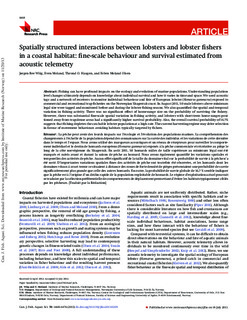| dc.contributor.author | Wiig, Jørgen Ree | |
| dc.contributor.author | Moland, Even | |
| dc.contributor.author | Haugen, Thrond O. | |
| dc.contributor.author | Olsen, Esben Moland | |
| dc.date.accessioned | 2013-11-20T15:03:46Z | |
| dc.date.available | 2013-11-20T15:03:46Z | |
| dc.date.issued | 2013-07-18 | |
| dc.identifier.citation | Canadian Journal of Fisheries and Aquatic Sciences, 2013, 70(10): 1468-1476, 10.1139/cjfas-2013-0209 | no_NO |
| dc.identifier.issn | 1205-7533 | |
| dc.identifier.issn | 0706-652x | |
| dc.identifier.uri | http://hdl.handle.net/11250/109071 | |
| dc.description.abstract | Fishing can have profound impacts on the ecology and evolution of marine populations. Understanding population-level changes ultimately depends on knowledge about individual survival and how it varies in time and space. We used acoustic tags and a network of receivers to monitor individual behaviour and fate of European lobster (Homarus gammarus) exposed to commercial and recreational trap fisheries on the Norwegian Skagerrak coast. In August 2011, 50 male lobsters above minimum legal size were tagged and monitored before and during the lobster fishing season. We also quantified the spatial and temporal variation in fishing activity. There was no significant effect of home-range size on the probability of surviving the fishery. However, there was substantial fine-scale spatial variation in fishing activity, and lobsters with short-term home ranges positioned away from trap-dense areas had a significantly higher survival probability. Also, the overall survival probability of 16.7% suggests that fishing depletes the catchable lobster population at a high rate. The current harvesting regime may drive selection in favour of movement behaviours avoiding habitats typically targeted by fishers. | no_NO |
| dc.language.iso | eng | no_NO |
| dc.publisher | NRC Press | no_NO |
| dc.title | Spatially structured interactions between lobsters and lobster fishers in a coastal habitat: fine-scale behaviour and survival estimated from acoustic telemetry | no_NO |
| dc.type | Journal article | no_NO |
| dc.type | Peer reviewed | no_NO |
| dc.subject.nsi | VDP::Agriculture and fishery disciplines: 900::Fisheries science: 920::Resource biology: 921 | no_NO |
| dc.source.pagenumber | 1468-1476 | no_NO |
| dc.source.volume | 70 | no_NO |
| dc.source.journal | Canadian Journal of Fisheries and Aquatic Sciences | no_NO |
| dc.source.issue | 10 | no_NO |
| dc.identifier.doi | 10.1139/cjfas-2013-0209 | |
| dc.relation.project | Research Council of Norway: 201917/F20 | no_NO |
